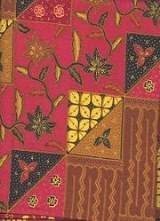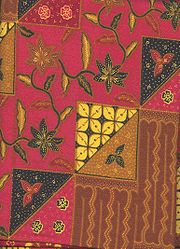
Malong
Encyclopedia

Okir
Okkir or okkil is the term for geometric and flowing designs and folk motifs that can be usually found in Maranao and Muslim-influenced artwork, especially in the southern Philippines, and in some parts of Southeast Asia...
designs. The malong is akin to the sarong
Sarong
A sarong or sarung is a large tube or length of fabric, often wrapped around the waist and worn as a kilt by men and as a skirt by women throughout much of South Asia, Southeast Asia, the Arabian Peninsula, the Horn of Africa, and on many Pacific islands. The fabric most often has woven plaid or...
worn by peoples in Malaysia, Brunei
Brunei
Brunei , officially the State of Brunei Darussalam or the Nation of Brunei, the Abode of Peace , is a sovereign state located on the north coast of the island of Borneo, in Southeast Asia...
and Indonesia
Indonesia
Indonesia , officially the Republic of Indonesia , is a country in Southeast Asia and Oceania. Indonesia is an archipelago comprising approximately 13,000 islands. It has 33 provinces with over 238 million people, and is the world's fourth most populous country. Indonesia is a republic, with an...
. The malong is traditionally used as a garment by numerous tribes in the Southern Philippines and the Sulu Archipelago
Sulu Archipelago
The Sulu Archipelago is a chain of islands in the southwestern Philippines. This archipelago is considered to be part of the Moroland by the local rebel independence movement. This island group forms the northern limit of the Celebes Sea....
.
Handwoven malongs are made by Maranao
Maranao
Maranao is the term used for the people of Lanao, a predominantly Muslim region in the Philippines island of Mindanao. They are famous for their artwork, sophisticated weaving, wood and metal craft, and their epic literature...
, Maguindanao
Maguindanao
Maguindanao is a province of the Philippines located in the Autonomous Region in Muslim Mindanao . Its capital is Shariff Aguak. It borders Lanao del Sur to the north, Cotabato to the east, and Sultan Kudarat to the south....
, and T'boli weavers on a backstrap loom. The pattern or style of the malong may indicate the weaver's tribal origin, such as the Maranao malong landap. Very rare malong designs and styles can indicate the village in which the malong was made, for example, the extremely intricate malong rawatan made only by a handful of Maranao weavers in Lanao del Sur
Lanao del Sur
Lanao del Sur is a province of the Philippines located in the Autonomous Region in Muslim Mindanao . Its capital is Marawi City and borders Lanao del Norte to the north, Bukidnon to the east, and Maguindanao and Cotabato to the south. To the southwest lies Illana Bay, an arm of the Moro Gulf...
, Mindanao
Mindanao
Mindanao is the second largest and easternmost island in the Philippines. It is also the name of one of the three island groups in the country, which consists of the island of Mindanao and smaller surrounding islands. The other two are Luzon and the Visayas. The island of Mindanao is called The...
. Handwoven malongs, which are costly, are likely to be used only at social functions, to display the social and economic status of the wearer. While modern malongs are made of cotton and Lurex
Lurex
Lurex is the registered brand name for a type of yarn with a metallic appearance. The yarn is made from synthetic film, onto which a metallic aluminium, silver, Gold layer has been vaporised. "Lurex" may also refer to cloth created with the yarn....
threads, some contemporary handwoven malongs are made of inexpensive rayon thread, to reduce the manufacturing cost to the weaver and ultimate cost to the consumer. There are many grades of cotton thread, and the cost of a malong can also be reduced by using the lesser grades of cotton thread, or by creating a loose or coarse weave.
Machine-made printed cotton malongs are made in Indonesia specifically for export to the Philippines, and are commonly referred to as "batik" because the item is imported; those inexpensive machine-made malongs are used for everyday purposes. The designs of traditional handwoven designs are used in imported cotton from Thailand, allowing the purchaser to have a cotton machine-printed malong which, from a distance, convincingly mimics the look of a much more expensive handwoven malong.
The malong can function as a skirt for both men and women, a dress, a blanket, a sunshade, a bedsheet, a "dressing room", a hammock, a prayer mat, and other purposes. A newborn is wrapped in a malong, and as he grows this piece of cloth becomes a part of his daily life. When he dies, he is once again wrapped in a malong. Among traditional tribal peoples, the malong is used in everyday life. Even in areas where people wear Western-style clothing during the day, the malong is commonly used as sleepwear.The malong is also used in very big festivals, they wear this to show respect.
Reference: From the Rainbow's Varied Hue: Textiles of the Southern Philippines. Edited by Roy W. Hamilton. 1998. Fowler Museum of Cultural History, University of California at Los Angeles.

